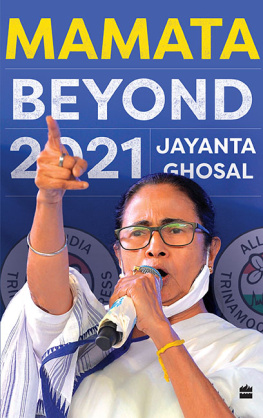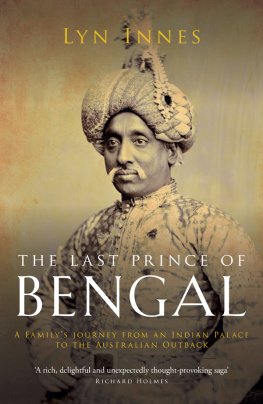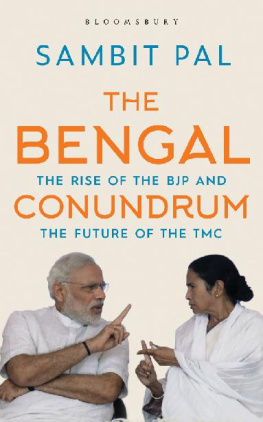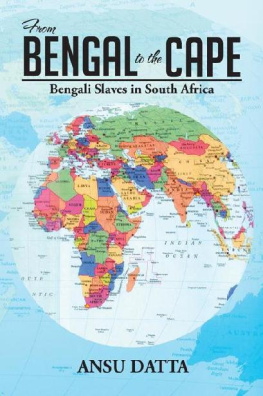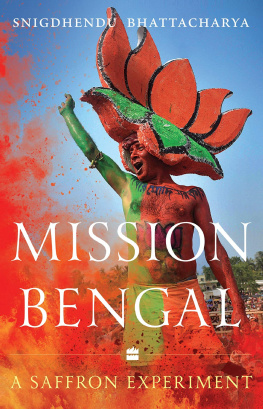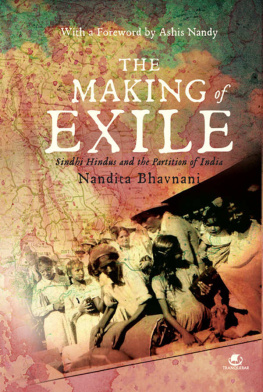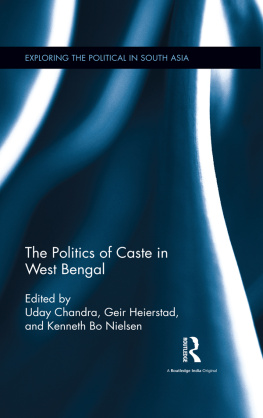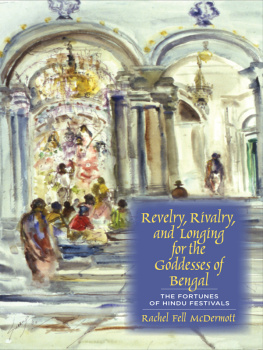Parna Sengupta - Pedagogy for Religion: Missionary Education and the Fashioning of Hindus and Muslims in Bengal
Here you can read online Parna Sengupta - Pedagogy for Religion: Missionary Education and the Fashioning of Hindus and Muslims in Bengal full text of the book (entire story) in english for free. Download pdf and epub, get meaning, cover and reviews about this ebook. year: 2011, publisher: Univ of California Press, genre: Religion. Description of the work, (preface) as well as reviews are available. Best literature library LitArk.com created for fans of good reading and offers a wide selection of genres:
Romance novel
Science fiction
Adventure
Detective
Science
History
Home and family
Prose
Art
Politics
Computer
Non-fiction
Religion
Business
Children
Humor
Choose a favorite category and find really read worthwhile books. Enjoy immersion in the world of imagination, feel the emotions of the characters or learn something new for yourself, make an fascinating discovery.

- Book:Pedagogy for Religion: Missionary Education and the Fashioning of Hindus and Muslims in Bengal
- Author:
- Publisher:Univ of California Press
- Genre:
- Year:2011
- Rating:5 / 5
- Favourites:Add to favourites
- Your mark:
- 100
- 1
- 2
- 3
- 4
- 5
Pedagogy for Religion: Missionary Education and the Fashioning of Hindus and Muslims in Bengal: summary, description and annotation
We offer to read an annotation, description, summary or preface (depends on what the author of the book "Pedagogy for Religion: Missionary Education and the Fashioning of Hindus and Muslims in Bengal" wrote himself). If you haven't found the necessary information about the book — write in the comments, we will try to find it.
Parna Sengupta: author's other books
Who wrote Pedagogy for Religion: Missionary Education and the Fashioning of Hindus and Muslims in Bengal? Find out the surname, the name of the author of the book and a list of all author's works by series.
Pedagogy for Religion: Missionary Education and the Fashioning of Hindus and Muslims in Bengal — read online for free the complete book (whole text) full work
Below is the text of the book, divided by pages. System saving the place of the last page read, allows you to conveniently read the book "Pedagogy for Religion: Missionary Education and the Fashioning of Hindus and Muslims in Bengal" online for free, without having to search again every time where you left off. Put a bookmark, and you can go to the page where you finished reading at any time.
Font size:
Interval:
Bookmark:
Pedagogy for Religion
Missionary Education and the Fashioning
of Hindus and Muslims in Bengal
Parna Sengupta

University of California Press, one of the most distinguished university presses in the United States, enriches lives around the world by advancing scholarship in the humanities, social sciences, and natural sciences. Its activities are supported by the UC Press Foundation and by philanthropic contributions from individuals and institutions. For more information, visit www.ucpress.edu .
University of California Press
Berkeley and Los Angeles, California
University of California Press, Ltd.
London, England
2011 by The Regents of the University of California
Library of Congress Cataloging-in-Publication Data
Sengupta, Parna, 1971
Pedagogy for religion : missionary education and the
fashioning of Hindus and Muslims in Bengal / Parna
Sengupta.
p. cm.
Includes bibliographical references (p. ) and index.
ISBN 978-0-520-26829-6 (hardcover: alk. paper)
ISBN 978-0-520-26831-9 (pbk.: alk. paper)
1. EducationIndiaBengalHistory. 2. HindusEducationIndiaBengalHistory. 3. MuslimsEducationIndiaBengalHistory. 4. Church schoolsIndiaBengalHistory. I. Title.
LA1154.B4S38 2011
371.07125414dc22 2011006067
Manufactured in the United States of America
20 19 18 17 16 15 14 13 12 11
10 9 8 7 6 5 4 3 2 1
This book is printed on Cascades Enviro 100, a 100% post consumer waste, recycled, de-inked fiber. FSC recycled certified and processed chlorine free. It is acid free, Ecologo certified, and manufactured by BioGas energy.
To my parents, Banasree and Dipankar Sengupta
Acknowledgment is far too inadequate a word to express my gratitude to the teachers, mentors, colleagues, and friends who have made this book possible. My research and writing has been funded at various stages by a number of organizations, including the Social Science Research Council, the Mellon Foundation, the Spencer Foundation, the National Academy of Education, and Carleton College.
I am grateful to have had the chance to work with Richard Candida-Smith, Fernando Coronil, Kali Israel, Aamir Mufti, Sumathi Ramaswamy, and Ann Stoler at the University of Michigan. Nick Dirks introduced me to the larger field of South Asian studies and the relevance of anthropology for the writing of history. Sankaran Krishna gave me a very early opportunity to present my work at the University of Hawaii and Itty Abraham was critical to the early funding of this project. Barbara Metcalf and Tom Metcalf have been wonderful critics, readers, and mentors. Most of all, I want to thank Tom Trautmann, who has not only taught me a tremendous amount about the world of early India but has also served as an exemplary model of the type of scholarly rigor, creativity, and intellectual curiosity to which I can only aspire.
My work has benefited tremendously from the intellectual exchange, friendship, and camaraderie of many, including Laura Bear, Tom Foster, Tyrone Forman, Will Glover, Tom Guglielmo, Anne Hardgrove, Riyad Koya, Amanda Lewis, Karuna Mantena, Rama Mantena, John McKiernan-Gonzalez, Farina Mir, Gita Rajan, Shimul Rahim, Anupama Rao, and the late Anjan Ghosh. My research in Kolkata would not have been possible without the home-away-from-home provided by my Choto Pisi, and Pisa, Deepak and Pritha Ray, and my cousins, Partha and Kaushik. In Dhaka, I was welcomed into the home of the Rahmed family, and for this I owe a great debt to Nipa Rahim. I am grateful to Caitlin Adams, Subham Basu, and Bhaskar Mukhopadhyay for helping me make my way through the archives of the British Library and the restaurants of London.
I am deeply indebted to my colleagues and students at Carleton College, especially Scott Bierman, Andrew Fisher, Annette Igra, Adeeb Khalid, Jessica Leiman, Lori Pearson, Alexander Persaud, Sabrina Singh, Dominic Vendell, Choua Vu, Serena Zabin, and Eleanor Zelliot. At Stanford, the support and encouragement of Shahzad Bashir, Nancy Hill, Sangeeta Mediratta, and Ellen Woods has been tremendous. This book has been vastly improved by suggestions from various journal editors and anonymous reviewers and I would like to especially thank Antoinette Burton, Tom Metcalf, Cynthia Talbot, Tom Trautmann, the anonymous reviewers at UC Press, and my editor, Niels Hooper.
My family has been a constant source of support, love, and encouragement. My interest in education is in no small part because of the value my own parents placed on learning and this book is dedicated to them. My sister, Tesha Sengupta-Irving, is a model of what engaged teaching and research should look like and I continue to learn from her example. I am grateful to the rest of my family, the Irvings, Ghoshes, and Sinhas, for their love, support, and good advice. The arrival of Arjun has blessed our lives and has made this a truly spectacular year.
Acknowledgment seems an especially inadequate word to express my gratitude to Aishwary Kumar. Our conversations constantly push my own thinkingon history, on writing, on reading, and on politicsin unexpected and wonderful ways. I thank him for all the cooking, the ideas, the books, and the sheer joy and love that he brings into my life every day.
This book challenges one of the most compelling historical fictions: that Western rule secularized the non-West. I confront this idea by demonstrating how the sustained involvement of missionaries in the expansion of modern education ultimately reinforced, rather than weakened, the place of religion and religious identity in the development of Indian modernity. My research questions the conclusions drawn by theorists of historical and contemporary imperialism who describe the missionary role as a self-consciously modernizing project... the Victorian NGO.
In describing missionary activity in this way, scholars are able to temper a general critique of Empire by emphasizing its humanitarian contribution to the welfare of the non-Western world. One of the commonly cited examples of this self-consciously modernizing project is the introduction of Western education, an imperial undertaking broadly credited to missionaries, who, as members of a Victorian NGO, were able to globalize the norms of Western liberalism.
My research reveals the paradox that the pursuit and adaptation of modern educational techniques and institutions, mainly exported to the colonies by Protestant missionaries, opened up new ways for Hindu and Muslim leaders and the colonial state to reformulate ideas of community along religious lines.as efforts to teach ordinary Indians what it meant to be a modern religious subject in ways that combined explicit religious beliefs with a set of implicit cultural practices and hierarchies.
In spite of the status accorded English education in colonial society and among historians of colonial India, my book demonstrates the centrality of vernacular education as a space in which missionaries and native leaders could theorize and ultimately propagate the practices and norms required of a properly modern society. Through a careful archival study of the methods, books, and institutions created by Christian, Hindu, and eventually Muslim educators in Bengal, my research reveals the ways the materials and institutions of vernacular education became a means to argue for a vision of community and identity based on religious affiliation.
By foregrounding education, I shift away from the conventional reliance on conversion, sacred text, or ritual practice as the primary means to understand religion and religious change. Rather, this book suggests that the very ordinary activity of learning to read in the modern school, through language primers and schoolteachers, became an exercise in individual and community religious self-fashioning in the colonial period. The pedagogic subject and the religious subject were, in these moments, wholly coterminous; thus, instruction in science also became a means to instruct the Indian child, whether Christian, Hindu, or Muslim, about the primacy of reason and rationality over superstition. The emphasis on literacy and reason as the heart of modern religious epistemology was part of a more general nineteenth-century reformist impulse all over the world. Modern education did not secularize religious traditions in India as much as it reformulated definitions of religion and religious community as a part of a more global process.
Next pageFont size:
Interval:
Bookmark:
Similar books «Pedagogy for Religion: Missionary Education and the Fashioning of Hindus and Muslims in Bengal»
Look at similar books to Pedagogy for Religion: Missionary Education and the Fashioning of Hindus and Muslims in Bengal. We have selected literature similar in name and meaning in the hope of providing readers with more options to find new, interesting, not yet read works.
Discussion, reviews of the book Pedagogy for Religion: Missionary Education and the Fashioning of Hindus and Muslims in Bengal and just readers' own opinions. Leave your comments, write what you think about the work, its meaning or the main characters. Specify what exactly you liked and what you didn't like, and why you think so.

